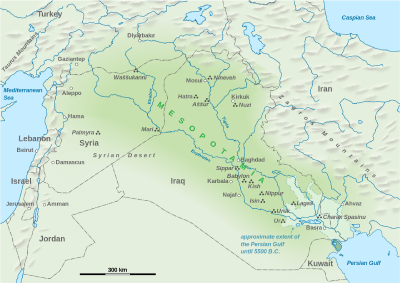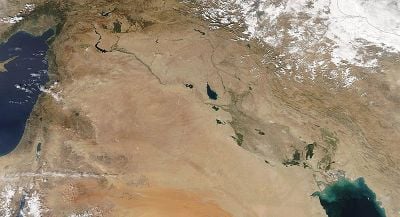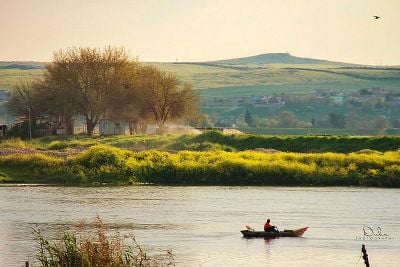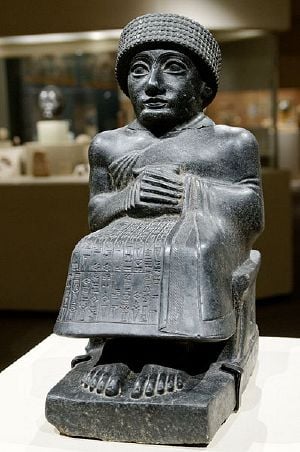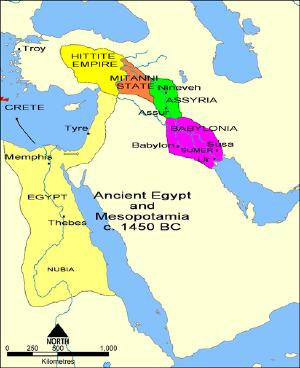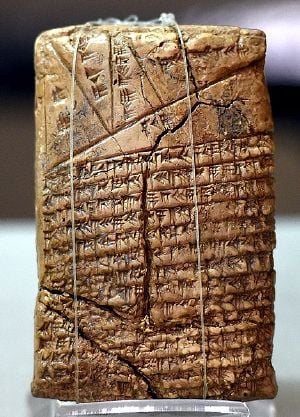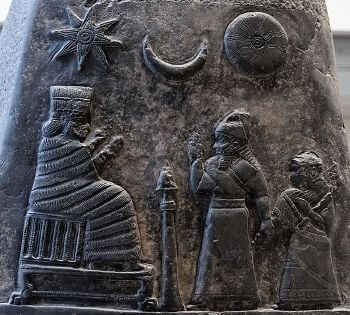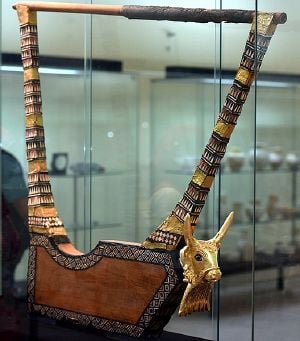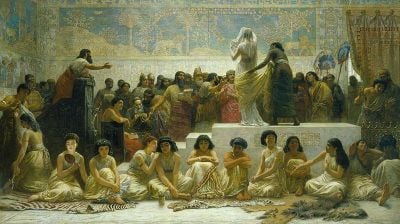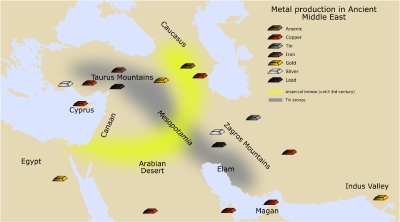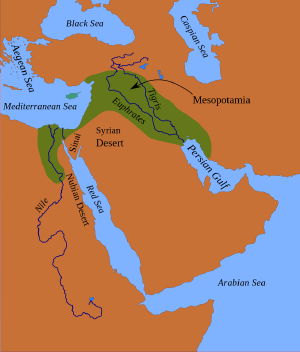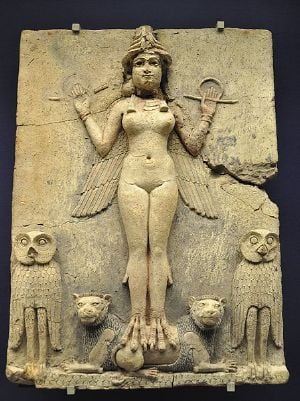Difference between revisions of "Mesopotamia" - New World Encyclopedia
| (19 intermediate revisions by the same user not shown) | |||
| Line 1: | Line 1: | ||
| − | {{Images OK}} | + | {{Images OK}}{{Submitted}}{{Approved}}{{Copyedited}} |
[[File:N-Mesopotamia and Syria english.png|thumb|400px|Map showing the extent of Mesopotamia. Shown are [[Washukanni]], [[Nineveh]], [[Hatra]], [[Assur]], [[Nuzi]], [[Palmyra]], [[Mari, Syria|Mari]], [[Sippar]], [[Babylon]], [[Kish (Sumer)|Kish]], [[Nippur]], [[Isin]], [[Lagash]], [[Uruk]], [[Charax Spasinu]] and [[Ur]], from north to south.]] | [[File:N-Mesopotamia and Syria english.png|thumb|400px|Map showing the extent of Mesopotamia. Shown are [[Washukanni]], [[Nineveh]], [[Hatra]], [[Assur]], [[Nuzi]], [[Palmyra]], [[Mari, Syria|Mari]], [[Sippar]], [[Babylon]], [[Kish (Sumer)|Kish]], [[Nippur]], [[Isin]], [[Lagash]], [[Uruk]], [[Charax Spasinu]] and [[Ur]], from north to south.]] | ||
| − | '''Mesopotamia'''<ref>{{lang-tr|Mezopotamya}}; {{lang-grc|Μεσοποταμία}} ''Mesopotamíā''; {{lang-ar|بِلَاد ٱلرَّافِدَيْن}} {{transl|ar|Bilād ar-Rāfidayn}} or {{lang|ar|بَيْنُ ٱلْنَهْرَيْن}} {{transl|ar|Bayn ul-Nahrayn}}; Classical Syriac: ܒܝܬ ܢܗܪ̈ܝܢ; Bēṯ Nahrēn</ref> is a [[historical region]] of [[West Asia]] situated within the [[Tigris–Euphrates river system]], in the northern part of the [[Fertile Crescent]] | + | '''Mesopotamia'''<ref>{{lang-tr|Mezopotamya}}; {{lang-grc|Μεσοποταμία}} ''Mesopotamíā''; {{lang-ar|بِلَاد ٱلرَّافِدَيْن}} {{transl|ar|Bilād ar-Rāfidayn}} or {{lang|ar|بَيْنُ ٱلْنَهْرَيْن}} {{transl|ar|Bayn ul-Nahrayn}}; Classical Syriac: ܒܝܬ ܢܗܪ̈ܝܢ; Bēṯ Nahrēn</ref> is a [[historical region]] of [[West Asia]] situated within the [[Tigris–Euphrates river system]], in the northern part of the [[Fertile Crescent]]; an area known as present-day [[Iraq]]. In the broader sense, the historical region of Mesopotamia included parts of present-day [[Iran]], [[Kuwait]], [[Syria]], and [[Turkey]]. |
| − | + | {{toc}} | |
Mesopotamia is the site of the earliest developments of the [[Neolithic Revolution]] from around 10,000 B.C.E. It has been identified as having inspired some of the most important developments in human history, including the invention of the [[wheel]], the planting of the first [[cereal]] [[crop]]s, and the development of [[cursive]] script, [[mathematics]], [[astronomy]], and [[agriculture]]. It is recognized as the cradle of some of the world's earliest civilizations. | Mesopotamia is the site of the earliest developments of the [[Neolithic Revolution]] from around 10,000 B.C.E. It has been identified as having inspired some of the most important developments in human history, including the invention of the [[wheel]], the planting of the first [[cereal]] [[crop]]s, and the development of [[cursive]] script, [[mathematics]], [[astronomy]], and [[agriculture]]. It is recognized as the cradle of some of the world's earliest civilizations. | ||
| Line 99: | Line 99: | ||
==Religion and philosophy== | ==Religion and philosophy== | ||
{{Main|Ancient Mesopotamian religion}} | {{Main|Ancient Mesopotamian religion}} | ||
| − | |||
| − | |||
Mesopotamians believed that the world was a flat disc, surrounded by a huge, holed space, and above that, [[heaven]].<ref>Wilfred G. Lambert, ''Ancient Mesopotamian Religion and Mythology: Selected Essays'' (Mohr Siebrek, 2016, ISBN 978-3161536748). </ref> They also believed that water was everywhere, the top, bottom and sides, and that the [[universe]] was born from this enormous sea. In addition, Mesopotamian religion was [[polytheism|polytheistic]]. The Sumerian word for universe is '''an-ki''', which refers to the god [[Anu|An]] and the goddess [[Ki (goddess)|Ki]].<ref>Norriss S. Hetherington (ed.), ''Encyclopedia of Cosmology: Historical, Philosophical, and Scientific Foundations of Modern Cosmology'' (Routledge, 2015, ISBN 978-1138778153).</ref> Their son was [[Enlil]], the air god. They believed that Enlil was the most powerful god, the chief god of the [[Pantheon (religion)|pantheon]]. | Mesopotamians believed that the world was a flat disc, surrounded by a huge, holed space, and above that, [[heaven]].<ref>Wilfred G. Lambert, ''Ancient Mesopotamian Religion and Mythology: Selected Essays'' (Mohr Siebrek, 2016, ISBN 978-3161536748). </ref> They also believed that water was everywhere, the top, bottom and sides, and that the [[universe]] was born from this enormous sea. In addition, Mesopotamian religion was [[polytheism|polytheistic]]. The Sumerian word for universe is '''an-ki''', which refers to the god [[Anu|An]] and the goddess [[Ki (goddess)|Ki]].<ref>Norriss S. Hetherington (ed.), ''Encyclopedia of Cosmology: Historical, Philosophical, and Scientific Foundations of Modern Cosmology'' (Routledge, 2015, ISBN 978-1138778153).</ref> Their son was [[Enlil]], the air god. They believed that Enlil was the most powerful god, the chief god of the [[Pantheon (religion)|pantheon]]. | ||
| Line 171: | Line 169: | ||
===Power=== | ===Power=== | ||
| − | When Assyria grew into an empire, it was divided into smaller parts, called [[provinces]]. Each of these were named after their main cities, like [[Nineveh]], [[Samaria]], [[Damascus]], and [[Arpad (Syria)|Arpad]]. They all had their own governor who had to make sure everyone paid their | + | When Assyria grew into an empire, it was divided into smaller parts, called [[provinces]]. Each of these were named after their main cities, like [[Nineveh]], [[Samaria]], [[Damascus]], and [[Arpad (Syria)|Arpad]]. They all had their own governor who had to make sure everyone paid their [[tax]]es. Governors also had to call up soldiers to war and supply workers when a temple was built. He was also responsible for enforcing the laws. In this way, it was easier to keep control of a large empire. Although Babylon was quite a small [[Sovereign state|state]] in Sumer, it grew tremendously throughout the time of [[Hammurabi]]'s rule. He was known as "the lawmaker" and created the [[Code of Hammurabi]], and soon [[Babylon]] became one of the main cities in Mesopotamia. It was later called Babylonia, which meant "the gateway of the gods." It also became one of history's greatest centers of learning. |
===Warfare=== | ===Warfare=== | ||
[[File:Campaign in southern Iraq of Ashurbanipal - fighting in the marshes.jpg|400px|thumb|Campaign in the [[Mesopotamian Marshes]] of southern [[Babylonia]] during the reign of [[Ashurbanipal]]. Showing Assyrian soldiers on boat chasing enemies trying to run away; some are hiding in the reeds]] | [[File:Campaign in southern Iraq of Ashurbanipal - fighting in the marshes.jpg|400px|thumb|Campaign in the [[Mesopotamian Marshes]] of southern [[Babylonia]] during the reign of [[Ashurbanipal]]. Showing Assyrian soldiers on boat chasing enemies trying to run away; some are hiding in the reeds]] | ||
[[File:Denis Bourez - British Museum, London (8747049029) (2).jpg|thumb|400px|The Standard of Ur; 2600 B.C.E. (the Early Dynastic Period III); shell, red limestone and lapis lazuli on wood; height: 21.7 cm, length: 50.4 cm; discovered at the [[Royal Cemetery at Ur]] (Dhi Qar Governorate, [[Iraq]])]] | [[File:Denis Bourez - British Museum, London (8747049029) (2).jpg|thumb|400px|The Standard of Ur; 2600 B.C.E. (the Early Dynastic Period III); shell, red limestone and lapis lazuli on wood; height: 21.7 cm, length: 50.4 cm; discovered at the [[Royal Cemetery at Ur]] (Dhi Qar Governorate, [[Iraq]])]] | ||
| − | With the end of the [[Uruk]] phase, walled cities grew and many isolated [[Ubaid period|Ubaid]] villages were abandoned indicating a rise in communal violence | + | With the end of the [[Uruk]] phase, walled cities grew and many isolated [[Ubaid period|Ubaid]] villages were abandoned, indicating a rise in communal violence. As [[city-states]] began to grow, their spheres of influence overlapped, creating arguments between other city-states, especially over land and canals. These arguments were recorded in tablets several hundreds of years before any major war—the first recording of a war occurred around 3200 B.C.E. but was not common until about 2500 B.C.E. |
| + | |||
| + | An [[Early Dynastic II]] king (Ensi) of Uruk in Sumer, Gilgamesh (c. 2600 B.C.E.), was commended for military exploits against [[Humbaba]] guardian of the Cedar Mountain, and was later celebrated in many later poems and songs in which he was claimed to be two-thirds god and only one-third human. The later [[Stele of the Vultures]] at the end of the [[Early Dynastic III]] period (2600–2350 B.C.E.), commemorating the victory of [[Eannatum]] of [[Lagash]] over the neighboring rival city of [[Umma]], is the oldest monument in the world that celebrates a massacre.<ref>Irene J. Winter, ''On Art in the Ancient Near East, Volume 2: From the Third Millennium B.C.E.'' (Brill Academic Pub., 2009, ISBN 978-9004174993).</ref> From this point forwards, warfare was incorporated into the Mesopotamian political system. At times a neutral city might act as an arbitrator for the two rival cities. This helped to form unions between cities, leading to regional states.<ref name=Dalling/> When empires were created, they went to war more with foreign countries. King Sargon, for example, conquered all the cities of Sumer, some cities in Mari, and then went to war with cities in modern-day Syria. Many Assyrian and Babylonian palace walls were decorated with the pictures of the successful fights and the enemy either desperately escaping or hiding amongst reeds. | ||
| − | The Neo-Babylonian kings used deportation as a means of control, like their predecessors, the Assyrians. For the Neo-Babylonian kings, war was a means to obtain tribute, plunder, sought after materials such as various metals and quality wood) and prisoners of war which could be put to work as | + | The Neo-Babylonian kings used deportation as a means of control, like their predecessors, the Assyrians. For the Neo-Babylonian kings, war was a means to obtain tribute, plunder, sought after materials such as various metals and quality wood) and [[prisoners of war]] which could be put to work as [[slave]]s in the temples which they built. The Assyrians had displaced populations throughout their vast empire, however, this particular practice under the Babylonian kings would appear to have been more limited, only being used to establish new populations in Babylonia itself. Though royal inscriptions from the Neo-Babylonian period don't speak of acts of destruction and deportation in the same boastful way royal inscriptions from the Neo-Assyrian period do, this however, does not prove that the practice ceased or that the Babylonians were less brutal than the Assyrians, since there is evidence that the city [[Ascalon]] was destroyed by [[Nebuchadnezzar II]] in 604 B.C.E.<ref name=Snell>Daniel C. Snell, (ed.), ''A Companion to the Ancient Near East'' (Wiley-Blackwell, 2007, ISBN 978-1405160018).</ref> |
===Laws=== | ===Laws=== | ||
| − | + | City-states of Mesopotamia created the first law codes, drawn from legal precedence and decisions made by kings. The codes of [[Urukagina]] and [[Lipit-Ishtar]] (the [[Code of Lipit-Ishtar]]) have been found. The most renowned of these is the [[Code of Hammurabi]] (created {{circa|1780 B.C.E.}}), which is one of the earliest sets of laws found and one of the best preserved examples of this type of document from ancient Mesopotamia. Hammurabi codified over 200 laws for Mesopotamia. Examination of the laws show a progressive weakening of the rights of women, and increasing severity in the treatment of slaves.<ref> F. Charles Fensham, [https://www.journals.uchicago.edu/doi/10.1086/371679 "Widow, Orphan, and the Poor in Ancient near Eastern Legal and Wisdom Literature"] ''Journal of Near Eastern Studies'' 21(2) (April 1962): 129–139. Retrieved March 25, 2024.</ref> | |
| − | City-states of Mesopotamia created the first law codes, drawn from legal precedence and decisions made by kings. The codes of [[Urukagina]] and [[Lipit-Ishtar]] (the [[Code of Lipit-Ishtar]]) have been found. The most renowned of these | ||
| − | |||
==Art== | ==Art== | ||
| − | + | [[Image:lilitu.jpg|thumb|300px|The ''[[Burney Relief]],'' "Queen of the Night", ca. 1950 B.C.E.]] | |
| − | The art of Mesopotamia | + | The art of Mesopotamia rivaled that of [[Ancient Egypt]] as the most grand, sophisticated and elaborate in western [[Eurasia]] from the fourth millennium B.C.E. until the [[Persia]]n [[Achaemenid Empire]] conquered the region in the sixth century B.C.E. The main emphasis was on various, very durable, forms of [[sculpture]] in [[stone]] and [[clay]]; little [[painting]] has survived, but what has suggests that painting was mainly used for geometrical and plant-based decorative schemes, though most sculpture was also painted. |
| − | The [[Protoliterate period]], dominated by [[Uruk]], saw the production of sophisticated works like the [[Warka Vase]] and [[cylinder seal]]s.The [[Guennol Lioness]] is an outstanding small [[limestone]] figure from [[Elam]] of about 3000–2800 | + | The [[Protoliterate period]], dominated by [[Uruk]], saw the production of sophisticated works like the [[Warka Vase]] and [[cylinder seal]]s. The [[Guennol Lioness]] is an outstanding small [[limestone]] figure from [[Elam]] of about 3000–2800 B.C.E., part man and part lion. A little later there are a number of figures of large-eyed priests and worshipers, mostly in alabaster and up to a foot high, who attended temple [[cult image]]s of the deity, but very few of these have survived. Sculptures from the [[Sumer]]ian and [[Akkadian Empire|Akkadian]] period generally had large, staring eyes, and long beards on the men. Many masterpieces have also been found at the Royal Cemetery at [[Ur]] (c. 2650 B.C.E.), including the two figures of a ''[[Ram in a Thicket]]'', the ''[[Copper Bull]]'' and a bull's head on one of the [[Lyres of Ur]]<ref name=Frankfort>Henri Frankfort, ''The Art and Architecture of the Ancient Orient'' (Puffin, 1977, ISBN 978-0140561074).</ref> |
| − | From the many subsequent periods before the | + | From the many subsequent periods before the ascendancy of the Neo-Assyrian Empire Mesopotamian art survives in a number of forms: cylinder seals, relatively small figures in the round, and reliefs of various sizes, including cheap plaques of molded pottery for the home, some religious and some apparently not. The [[Burney Relief]] is an unusual elaborate and relatively large (20 x 15 inches) [[terracotta]] plaque of a naked winged goddess with the feet of a bird of prey, and attendant owls and lions. It comes from the eighteenth or nineteenth century B.C.E., and may also be molded. Stone [[stela]]e, [[votive offering]]s, or ones probably commemorating victories and showing feasts, are also found from temples, which unlike more official ones lack inscriptions that would explain them; the fragmentary [[Stele of the Vultures]] is an early example of the inscribed type, and the Assyrian [[Black Obelisk of Shalmaneser III]] a large and solid late one.<ref name=Frankfort/> |
| − | The conquest of the whole of Mesopotamia and much surrounding territory by the Assyrians created a larger and wealthier state than the region had known before, and very grandiose art in palaces and public places, no doubt partly intended to match the | + | The conquest of the whole of Mesopotamia and much surrounding territory by the Assyrians created a larger and wealthier state than the region had known before, and very grandiose art in palaces and public places, no doubt partly intended to match the splendor of the art of the neighboring Egyptian empire. The Assyrians developed a style of extremely large schemes of very finely detailed narrative low reliefs in stone for palaces, with scenes of war or hunting. They produced very little sculpture in the round, except for colossal guardian figures, often the human-headed [[lamassu]], which are sculpted in high relief on two sides of a rectangular block, with the heads effectively in the round (and also five legs, so that both views seem complete). Even before dominating the region they had continued the cylinder seal tradition with designs which are often exceptionally energetic and refined.<ref name=Frankfort/> |
<gallery> | <gallery> | ||
| − | File:Mask of Sargon of Akkad.jpg|Bronze head of an Akkadian ruler, discovered in [[Nineveh]] in 1931, presumably depicting either [[Sargon of Akkad]] or Sargon's grandson [[Naram-Sin of Akkad|Naram-Sin]]. | + | File:Mask of Sargon of Akkad.jpg|Bronze head of an Akkadian ruler, discovered in [[Nineveh]] in 1931, presumably depicting either [[Sargon of Akkad]] or Sargon's grandson [[Naram-Sin of Akkad|Naram-Sin]]. |
| − | File:Striding lions - Processional Way of Babylon - Pergamonmuseum - Berlin - Germany 2017.jpg|Striding lions from the Processional Street of [[Babylon]] | + | File:Striding lions - Processional Way of Babylon - Pergamonmuseum - Berlin - Germany 2017.jpg|Striding lions from the Processional Street of [[Babylon]] |
| − | File:Assyrian Winged Bull.jpg| | + | File:Assyrian Winged Bull.jpg|Initially depicted as a goddess in Sumerian times, called ''Lamma'', later depicted from Assyrian times as a hybrid of a human, bird, and either a bull or lion, under the name ''Lamassu'' |
File:Ancient Egyptian, Assyrian, and Persian costumes and decorations (1920) (14741970056).jpg|Assyrian ornaments and patterns, illustrated in a book from 1920 | File:Ancient Egyptian, Assyrian, and Persian costumes and decorations (1920) (14741970056).jpg|Assyrian ornaments and patterns, illustrated in a book from 1920 | ||
| − | File:Detail, Nebuchadnezzar II's Building Inscription plaque of the Ishtar Gate, from Babylon, Iraq. 6th century B.C.E. Pergamon Museum.jpg | + | File:Detail, Nebuchadnezzar II's Building Inscription plaque of the Ishtar Gate, from Babylon, Iraq. 6th century B.C.E. Pergamon Museum.jpg|Detail of Nebuchadnezzar II's Building Inscription plaque of the Ishtar Gate, from [[Babylon]] |
| − | File:Artist’s impression of a hall in an Assyrian palace from The Monuments of Nineveh by Sir Austen Henry Layard, 1853.jpg | + | File:Artist’s impression of a hall in an Assyrian palace from The Monuments of Nineveh by Sir Austen Henry Layard, 1853.jpg|Artist's impression of a hall in an Assyrian palace from ''The Monuments of Nineveh'' by [[Austen Henry Layard]], 1853 |
| − | File:Ashur god.jpg | + | File:Ashur god.jpg|A [[Neo-Assyrian]] relief of Ashur as a [[feather robed archer]] holding a bow instead of a ring (ninth-eighth century B.C.E.) |
| − | File:The Assyrian king Shalmaneser III receives tribute from Sua, king of Gilzanu, The Black Obelisk..JPG | + | File:The Assyrian king Shalmaneser III receives tribute from Sua, king of Gilzanu, The Black Obelisk..JPG|The [[Black Obelisk of Shalmaneser III]]. The king, surrounded by his royal attendants and a high-ranking official, receives a tribute from Sua, king of Gilzanu (north-west Iran), who bows and prostrates before the king. From [[Nimrud]] |
| − | File:Genien, Nimrud 870 v. Chr. Aegyptisches Museum, Muenchen-4.jpg | + | File:Genien, Nimrud 870 v. Chr. Aegyptisches Museum, Muenchen-4.jpg|"[[Winged genie]]", [[Nimrud]] c. 870 B.C.E., with inscription running across his midriff. |
</gallery> | </gallery> | ||
==Architecture== | ==Architecture== | ||
{{Main|Architecture of Mesopotamia}} | {{Main|Architecture of Mesopotamia}} | ||
| − | The study of ancient Mesopotamian architecture is based on available [[archaeological]] evidence, pictorial representation of buildings, and texts on building practices. Scholarly literature usually concentrates on temples, palaces, city walls and gates, and other monumental buildings, but occasionally one finds works on residential architecture as well.<ref | + | The study of ancient Mesopotamian architecture is based on available [[archaeological]] evidence, pictorial representation of buildings, and texts on building practices. Scholarly literature usually concentrates on temples, palaces, city walls and gates, and other monumental buildings, but occasionally one finds works on residential architecture as well.<ref name=Snell/> Archaeological surface surveys also allowed for the study of urban form in early Mesopotamian cities. |
| − | Brick is the dominant material, as the material was freely available locally, whereas building stone had to be brought a considerable distance to most cities. | + | [[Brick]] is the dominant material, as the material was freely available locally, whereas building stone had to be brought a considerable distance to most cities. The [[ziggurat]] is the most distinctive form, and cities often had large gateways, of which the [[Ishtar Gate]] from Neo-Babylonian Babylon, decorated with beasts in polychrome brick, is the most famous, now largely in the [[Pergamon Museum]] in [[Berlin]]. |
| − | The most notable architectural remains from early Mesopotamia are the temple complexes at [[Uruk]] from the | + | The most notable architectural remains from early Mesopotamia are the temple complexes at [[Uruk]] from the fourth millennium B.C.E., temples and palaces from the [[Early Dynastic Period (Mesopotamia)|Early Dynastic period]] sites in the [[Diyala River]] valley such as Khafajah and Tell Asmar, the [[Third Dynasty of Ur]] remains at [[Nippur]] (Sanctuary of [[Enlil]]) and [[Ur]] (Sanctuary of [[Sin (mythology)|Nanna]]), Middle [[Bronze Age]] remains at Syrian-Turkish sites of [[Ebla]], [[Mari, Syria|Mari]], [[Alalakh]], [[Aleppo]], and [[Kultepe]], Late Bronze Age palaces at [[Hattusa]], [[Ugarit]], [[Assur|Ashur]], and [[Nuzi]], Iron Age palaces and temples at [[Assyria]]n ([[Kalhu]]/Nimrud, [[Khorsabad]], [[Nineveh]]), [[Babylonia]]n ([[Babylon]]), [[Urartian]] ([[Tushpa]]/Van, Kalesi, Cavustepe, Ayanis, [[Armavir, Armenia|Armavir]], [[Yerevan|Erebuni]], [[Bastam]]), and [[Neo-Hittite]] sites ([[Carchemish|Karkamis]], [[Tell Halaf]], [[Karatepe]]). Houses are mostly known from Old Babylonian remains at Nippur and Ur. Among the textual sources on building construction and associated rituals are Gudea's cylinders from the late third millennium are notable, as well as the Assyrian and Babylonian royal inscriptions from the [[Iron Age]]. |
<gallery> | <gallery> | ||
| − | File:Ishtar Gate.gif|The [[Ishtar Gate|Ishtar gate]] was constructed in about 575 | + | File:Ishtar Gate.gif|The [[Ishtar Gate|Ishtar gate]] was constructed in about 575 B.C.E. by order of King [[Nebuchadnezzar II]]. [[Pergamon Museum]], Berlin |
File:Street in Babylon.jpg|The walls of Babylon, in [[Babylon]] | File:Street in Babylon.jpg|The walls of Babylon, in [[Babylon]] | ||
File:Zig front right side.JPG|[[Ziggurat of Ur|Ziggurat]] of Ur | File:Zig front right side.JPG|[[Ziggurat of Ur|Ziggurat]] of Ur | ||
| − | File:The ziggurat at Aqar Quf.jpg|Ziggurat of [[Dur-Kurigalzu|Dur-kuriagalzu]] | + | File:The ziggurat at Aqar Quf.jpg|Ziggurat of [[Dur-Kurigalzu|Dur-kuriagalzu]] |
File:SumerianZiggurat.jpg|A suggested reconstruction of the appearance of a Sumerian [[ziggurat]] | File:SumerianZiggurat.jpg|A suggested reconstruction of the appearance of a Sumerian [[ziggurat]] | ||
| − | File:20160105-Abraham house in Ur Iraq.jpg | + | File:20160105-Abraham house in Ur Iraq.jpg|The alleged [[Abraham]] house in [[Ur]] |
</gallery> | </gallery> | ||
| Line 236: | Line 234: | ||
* Eves, Howard. ''An Introduction to the History of Mathematics''. Cengage Learning, 1990. ISBN 0030295580 | * Eves, Howard. ''An Introduction to the History of Mathematics''. Cengage Learning, 1990. ISBN 0030295580 | ||
* Foster, Benjamin R., and Karen Polinger Foster. ''Civilizations of Ancient Iraq''. Princeton University Press, 2009. ISBN 978-0691137223 | * Foster, Benjamin R., and Karen Polinger Foster. ''Civilizations of Ancient Iraq''. Princeton University Press, 2009. ISBN 978-0691137223 | ||
| + | * Frankfort, Henri. ''The Art and Architecture of the Ancient Orient''. Puffin, 1977. ISBN 978-0140561074 | ||
* Guo, Rongxing. ''An Economic Inquiry into the Nonlinear Behaviors of Nations: Dynamic Developments and the Origins of Civilizations''. Palgrave Macmillan, 2017. ISBN 978-3319487717 | * Guo, Rongxing. ''An Economic Inquiry into the Nonlinear Behaviors of Nations: Dynamic Developments and the Origins of Civilizations''. Palgrave Macmillan, 2017. ISBN 978-3319487717 | ||
* Harris, Rivkah. ''Gender and Aging in Mesopotamia''. University of Oklahoma Press, 2000. ISBN 978-0806131672 | * Harris, Rivkah. ''Gender and Aging in Mesopotamia''. University of Oklahoma Press, 2000. ISBN 978-0806131672 | ||
| Line 246: | Line 245: | ||
* Pollock, Susan. ''Ancient Mesopotamia: The Eden that Never Was''. Cambridge University Press, 1999. ISBN 978-0521573344 | * Pollock, Susan. ''Ancient Mesopotamia: The Eden that Never Was''. Cambridge University Press, 1999. ISBN 978-0521573344 | ||
* Sanders, Seth L. (ed.). ''Margins of Writing, Origins of Cultures''. Oriental Institute of the University of Chicago, 2006. ISBN 978-1885923394 | * Sanders, Seth L. (ed.). ''Margins of Writing, Origins of Cultures''. Oriental Institute of the University of Chicago, 2006. ISBN 978-1885923394 | ||
| + | * Snell, Daniel C. (ed.). ''A Companion to the Ancient Near East''. Wiley-Blackwell, 2007. ISBN 978-1405160018 | ||
* Stol, Marten. ''Epilepsy in Babylonia''. Brill, 1993. ISBN 978-9072371638 | * Stol, Marten. ''Epilepsy in Babylonia''. Brill, 1993. ISBN 978-9072371638 | ||
* Struik, Dirk J. ''A Concise History of Mathematics''. Dover Publications, 1987. ISBN 978-0486602554 | * Struik, Dirk J. ''A Concise History of Mathematics''. Dover Publications, 1987. ISBN 978-0486602554 | ||
Latest revision as of 19:20, 25 March 2024
Mesopotamia[1] is a historical region of West Asia situated within the Tigris–Euphrates river system, in the northern part of the Fertile Crescent; an area known as present-day Iraq. In the broader sense, the historical region of Mesopotamia included parts of present-day Iran, Kuwait, Syria, and Turkey.
Mesopotamia is the site of the earliest developments of the Neolithic Revolution from around 10,000 B.C.E. It has been identified as having inspired some of the most important developments in human history, including the invention of the wheel, the planting of the first cereal crops, and the development of cursive script, mathematics, astronomy, and agriculture. It is recognized as the cradle of some of the world's earliest civilizations.
Etymology
The regional toponym Mesopotamia (/ˌmɛsəpəˈteɪmiə/, Ancient Greek: Μεσοποταμία '[land] between rivers'; "(land) between the (two) rivers") comes from the ancient Greek root words μέσος (mesos, 'middle') and ποταμός (potamos, 'river')[2] and translates to '(land) between rivers,' likely being a calque of the older Aramaic term, with the Aramaic term itself likely being a calque of the Akkadian birit narim. It is used throughout the Greek Septuagint (c. 250 B.C.E.) to translate the Hebrew and Aramaic equivalent Naharaim. An even earlier Greek usage of the name Mesopotamia is evident from The Anabasis of Alexander, which was written in the late second century C.E. but specifically refers to sources from the time of Alexander the Great. In the Anabasis, Mesopotamia was used to designate the land east of the Euphrates in north Syria.
Later, the term Mesopotamia was more generally applied to all the lands between the Euphrates and the Tigris, thereby incorporating not only parts of Syria but also almost all of Iraq and southeastern Turkey.[3] The neighboring steppes to the west of the Euphrates and the western part of the Zagros Mountains are also often included under the wider term Mesopotamia.[4]
A further distinction is often made between Northern or Upper Mesopotamia and Southern or Lower Mesopotamia. Upper Mesopotamia, also known as the Jazira, is the area between the Euphrates and the Tigris from their sources down to Baghdad. Lower Mesopotamia is the area from Baghdad to the Persian Gulf and includes Kuwait and parts of western Iran.[5]
History
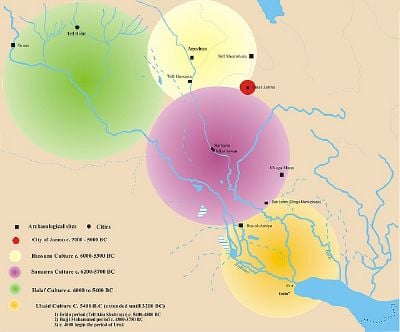
Mesopotamia is the site of the earliest developments of the Neolithic Revolution from around 10,000 B.C.E. It has been identified as having inspired some of the most important developments in human history, including the invention of the wheel, the planting of the first cereal crops, and the development of cursive script, mathematics, astronomy, and agriculture. It is recognized as the cradle of some of the world's earliest civilizations.[6]
The region was one of the four River valley civilizations where writing was invented, along with the Nile valley in Ancient Egypt, the Indus Valley civilization in the Indian subcontinent, and the Yellow River in Ancient China. Mesopotamia housed historically important cities such as Uruk, Nippur, Nineveh, Assur and Babylon, as well as major territorial states such as the city of Eridu, the Akkadian kingdoms, the Third Dynasty of Ur, and the various Assyrian empires. Some of the important historical Mesopotamian leaders were Ur-Nammu (king of Ur), Sargon of Akkad (who established the Akkadian Empire), Hammurabi (who established the Old Babylonian state), Ashur-uballit I and Tiglath-Pileser I (who established the Assyrian Empire).
The Sumerians and Akkadians (including Assyrians and Babylonians), each originating from different areas, dominated Mesopotamia from the beginning of recorded history (c. 3100 B.C.E.) to the fall of Babylon in 539 B.C.E., when it was conquered by the Achaemenid Empire. Mesopotamia was next conquered by Alexander the Great in 332 B.C.E., and after his death, it became part of the Greek Seleucid Empire.
Around 150 B.C.E., Mesopotamia was under the control of the Parthian Empire. It became a battleground between the Romans and Parthians, with western parts of the region coming under ephemeral Roman control. In 226 C.E., the eastern regions of Mesopotamia fell to the Sassanid Persians. The division of the region between the Roman (Byzantine Empire from 395 C.E.) and Sassanid Empires lasted until the seventh century Muslim conquest of Persia from the Sasanian Empire and the Muslim conquest of the Levant from the Byzantines. A number of primarily neo-Assyrian and Christian native Mesopotamian states existed between the first century B.C.E. and third century C.E., including Adiabene, Osroene, and Hatra.
Today, Mesopotamia is known as Iraq.[6] In the broader sense, the historical region of Mesopotamia included parts of present-day Iran, Kuwait, Syria, and Turkey.[7]
Geography

Mesopotamia encompasses the land between the Euphrates and Tigris rivers, both of which have their headwaters in the neighboring Armenian highlands. Both rivers are fed by numerous tributaries, and the entire river system drains a vast mountainous region. Overland routes in Mesopotamia usually follow the Euphrates because the banks of the Tigris are frequently steep and difficult. The climate of the region is semi-arid with a vast desert expanse in the north which gives way to a 15,000-square-kilometer (5,800 sq mi) region of marshes, lagoons, mudflats, and reed banks in the south. In the extreme south, the Euphrates and the Tigris unite and empty into the Persian Gulf.
The arid environment ranges from the northern areas of rain-fed agriculture to the south where irrigation of agriculture is essential.[9] This irrigation is aided by a high water table and by melting snows from the high peaks of the northern Zagros Mountains and from the Armenian Highlands, the source of the Tigris and Euphrates Rivers that give the region its name. The usefulness of irrigation depends upon the ability to mobilize sufficient labor for the construction and maintenance of canals, and this, from the earliest period, has assisted the development of urban settlements and centralized systems of political authority.
Agriculture throughout the region has been supplemented by nomadic pastoralism, where tent-dwelling nomads herded sheep and goats (and later camels) from the river pastures in the dry summer months, out into seasonal grazing lands on the desert fringe in the wet winter season. The area is generally lacking in building stone, precious metals, and timber, and so historically has relied upon long-distance trade of agricultural products to secure these items from outlying areas.[9] In the marshlands to the south of the area, a complex water-borne fishing culture has existed since prehistoric times and has added to the cultural mix.
Language and writing
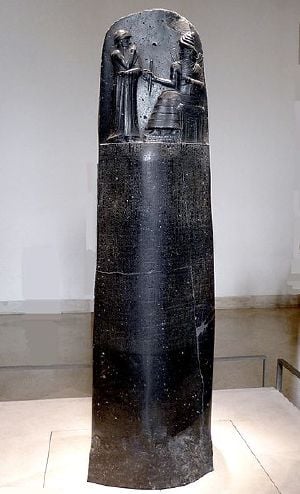
The earliest language written in Mesopotamia was Sumerian, an agglutinative language isolate. Along with Sumerian, Semitic languages were also spoken in early Mesopotamia.[10] Subartuan, a language of the Zagros possibly related to the Hurro-Urartuan language family, is attested in personal names, rivers and mountains, and in various crafts. Akkadian came to be the dominant language during the Akkadian Empire and the Assyrian empires, but Sumerian was retained for administrative, religious, literary and scientific purposes. Different varieties of Akkadian were used until the end of the Neo-Babylonian period. Old Aramaic, which had already become common in Mesopotamia, then became the official provincial administration language of first the Neo-Assyrian Empire, and then the Achaemenid Empire: the official lect is called Imperial Aramaic. Akkadian fell into disuse, but both it and Sumerian were still used in temples for some centuries. The last Akkadian texts date from the late first century C.E.
Early in Mesopotamia's history (around the mid-fourth millennium B.C.E.) cuneiform was invented for the Sumerian language. Cuneiform literally means "wedge-shaped," due to the triangular tip of the stylus used for impressing signs on wet clay. The standardized form of each cuneiform sign appears to have been developed from pictograms.
The early logographic system of cuneiform script took many years to master. Thus, only a limited number of individuals were hired as scribes to be trained in its use. It was not until the widespread use of a syllabic script was adopted under Sargon's rule that significant portions of the Mesopotamian population became literate.[11] Massive archives of texts were recovered from the archaeological contexts of Old Babylonian scribal schools, through which literacy was disseminated.
Akkadian gradually replaced Sumerian as the spoken language of Mesopotamia somewhere around the turn of the thirrd and the second millennium B.C.E. (the exact dating being a matter of debate),[12] but Sumerian continued to be used as a sacred, ceremonial, literary, and scientific language in Mesopotamia until the first century C.E.
Literature
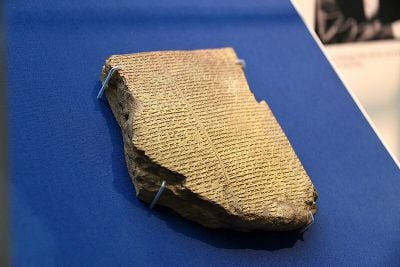
Libraries were extant in towns and temples during the Babylonian Empire. An old Sumerian proverb averred that "he who would excel in the school of the scribes must rise with the dawn." Women as well as men learned to read and write,[13] and for the Semitic Babylonians, this involved knowledge of the extinct Sumerian language, and a complicated and extensive syllabary.
A considerable amount of Babylonian literature was translated from Sumerian originals, and the language of religion and law long continued to be the old agglutinative language of Sumer. Vocabularies, grammars, and interlinear translations were compiled for the use of students, as well as commentaries on the older texts and explanations of obscure words and phrases. The characters of the syllabary were all arranged and named, and elaborate lists were drawn up.
Many Babylonian literary works are still studied today. One of the most famous of these was the Epic of Gilgamesh, in twelve books, translated from the original Sumerian by a certain Sîn-lēqi-unninni, and arranged upon an astronomical principle. Each division contains the story of a single adventure in the career of Gilgamesh. The whole story is a composite product, although it is probable that some of the stories are artificially attached to the central figure.
Science and technology
Mathematics
Mesopotamian mathematics and science was based on a sexagesimal (base 60) numeral system. This is the source of the 60-minute hour, the 24-hour day, and the 360-degree circle. The Sumerian calendar was lunisolar, with three seven-day weeks in a lunar month. This form of mathematics was instrumental in early map-making. The Babylonians also had theorems on how to measure the area of several shapes and solids. They measured the circumference of a circle as three times the diameter and the area as one-twelfth the square of the circumference, which would be correct if π were fixed at 3. The volume of a cylinder was taken as the product of the area of the base and the height; however, the volume of the frustum of a cone or a square pyramid was incorrectly taken as the product of the height and half the sum of the bases. Also, there was a recent discovery in which a tablet used π as 25/8 (3.125 instead of 3.14159~). The Babylonians are also known for the Babylonian mile, which was a measure of distance equal to about seven modern miles (11 km). This measurement for distances eventually was converted to a time-mile used for measuring the travel of the Sun, therefore, representing time.[14]
Algebra
The roots of algebra can be traced to the ancient Babylonians[15] who developed an advanced arithmetical system with which they were able to do calculations in an algorithmic fashion.
The Babylonian clay tablet YBC 7289 (c. 1800–1600 B.C.E.) gives an approximation of √2 in four sexagesimal figures, 1 24 51 10,[16] which is accurate to about six decimal digits, and is the closest possible three-place sexagesimal representation of √2:
The Babylonians were not interested in exact solutions, but rather approximations, and so they would commonly use linear interpolation to approximate intermediate values.[17]
One of the most famous tablets is the Plimpton 322 tablet, created around 1900–1600 B.C.E., which gives a table of Pythagorean triples and represents some of the most advanced mathematics prior to Greek mathematics.[18]
Astronomy
From Sumerian times, temple priesthoods had attempted to associate current events with certain positions of the planets and stars. This continued to Assyrian times, when Limmu lists were created as a year by year association of events with planetary positions, which, when they have survived to the present day, allow accurate associations of relative with absolute dating for establishing the history of Mesopotamia.
The Babylonian astronomers were very adept at mathematics and could predict eclipses and Solstices. Scholars thought that everything had some purpose in astronomy. Most of these related to religion and omens. Mesopotamian astronomers worked out a 12-month calendar based on the cycles of the moon. They divided the year into two seasons: summer and winter. The origins of astronomy as well as astrology date from this time.
During the eighth and seventh centuries B.C.E., Babylonian astronomers developed a new approach to astronomy. They began studying philosophy dealing with the ideal nature of the early universe and began employing an internal logic within their predictive planetary systems. This was an important contribution to astronomy and the philosophy of science and some scholars have thus referred to this new approach as the first scientific revolution.[19] This new approach to astronomy was adopted and further developed in Greek and Hellenistic astronomy. In fact, Babylonian astronomy served as the basis for much of Greek, classical Indian, Sassanian, Byzantine, Syrian, medieval Islamic, Central Asian, and Western European astronomy.[20]
In Seleucid and Parthian times, the astronomical reports were thoroughly scientific; how much earlier their advanced knowledge and methods were developed is uncertain. The Babylonian development of methods for predicting the motions of the planets is considered to be a major episode in the history of astronomy.
The only Greek-Babylonian astronomer known to have supported a heliocentric model of planetary motion was Seleucus of Seleucia (b. 190 B.C.E.).[21] Seleucus is known from the writings of Plutarch. He supported Aristarchus of Samos' heliocentric theory where the Earth rotated around its own axis which in turn revolved around the sun. According to Plutarch, Seleucus even proved the heliocentric system, but it is not known what arguments he used (except that he correctly theorized on tides as a result of the moon's attraction).
Medicine
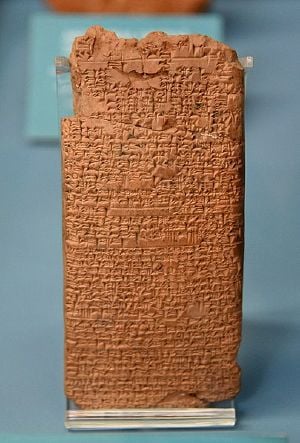
The oldest Babylonian texts on medicine date back to the Old Babylonian period in the first half of the second millennium B.C.E. The most extensive Babylonian medical text, however, is the Diagnostic Handbook written by the ummânū, or chief scholar, Esagil-kin-apli of Borsippa, during the reign of the Babylonian king Adad-apla-iddina (1069–1046 B.C.E.).[22]
Along with contemporary Egyptian medicine, the Babylonians introduced the concepts of diagnosis, prognosis, physical examination, enemas, and prescriptions. In addition, the Diagnostic Handbook introduced the methods of therapy and aetiology and the use of empiricism, logic, and rationality in diagnosis, prognosis, and therapy. The text contains a list of medical symptoms and often detailed empirical observations along with logical rules used in combining observed symptoms on the body of a patient with its diagnosis and prognosis.[22] Esagil-kin-apli also described the symptoms for many varieties of epilepsy and related ailments along with their diagnosis and prognosis.[23]
The symptoms and diseases of the patient were treated through therapeutic means such as bandages, creams, and pills. If a patient could not be cured physically, the Babylonian physicians often relied on exorcism to cleanse the patient from any curses. Esagil-kin-apli's Diagnostic Handbook was based on a logical set of axioms and assumptions, including the modern view that through the examination and inspection of the symptoms of a patient, it is possible to determine the patient's disease, its aetiology, its future development, and the chances of the patient's recovery.[22]
Technology
Mesopotamian people invented many technologies including metal and copper-working, glass and lamp making, textile weaving, flood control, water storage, and irrigation. They were also one of the first Bronze Age societies in the world. They developed from copper, bronze, and gold on to iron. Palaces were extensively decorated with these very expensive metals. Also, copper, bronze, and iron were used for armor as well as for different weapons such as swords, daggers, spears, and maces.
Religion and philosophy
Mesopotamians believed that the world was a flat disc, surrounded by a huge, holed space, and above that, heaven.[24] They also believed that water was everywhere, the top, bottom and sides, and that the universe was born from this enormous sea. In addition, Mesopotamian religion was polytheistic. The Sumerian word for universe is an-ki, which refers to the god An and the goddess Ki.[25] Their son was Enlil, the air god. They believed that Enlil was the most powerful god, the chief god of the pantheon.
Although these beliefs were held in common among Mesopotamians, there were also regional variations.
Philosophy
The numerous civilizations of the area influenced the Abrahamic religions, especially the Hebrew Bible; its cultural values and literary influence are especially evident in the Book of Genesis.[26]
Early Mesopotamian wisdom embodied certain philosophies of life, particularly ethics, in the forms of dialectic, dialogues, epic poetry, folklore, hymns, lyrics, prose works, and proverbs. Babylonian reason and rationality developed beyond empirical observation.[27]
Babylonian thought had a considerable influence on early Ancient Greek and Hellenistic philosophy. In particular, the Babylonian text Dialogue of Pessimism contains similarities to the agonistic thought of the Sophists, the Heraclitean doctrine of dialectic, and the dialogs of Plato, as well as a precursor to the Socratic method.[27]
Culture
Festivals
Ancient Mesopotamians had ceremonies each month. The theme of the rituals and festivals for each month was determined by at least six important factors:
- The Lunar phase (a waxing moon meant abundance and growth, while a waning moon was associated with decline, conservation, and festivals of the Underworld)
- The phase of the annual agricultural cycle
- Equinoxes and solstices
- The local mythos and its divine Patrons
- The success of the reigning Monarch
- The Akitu, or New Year Festival (first full moon after spring equinox)
- Commemoration of specific historical events (founding, military victories, temple holidays, etc.)
Music
Some songs were written for the gods but many were written to describe important events. Although music and songs amused kings, they were also enjoyed by ordinary people who liked to sing and dance in their homes or in the marketplaces.
Songs were sung to children who passed them on to their children. Thus songs were passed on through many generations as an oral tradition until writing was more universal. These songs provided a means of passing on through the centuries highly important information about historical events.
Games
Hunting was popular among Assyrian kings. Boxing and wrestling feature frequently in art, and some form of polo was probably popular, with men sitting on the shoulders of other men rather than on horses.[29]
They also played a board game similar to senet and backgammon, now known as the "Royal Game of Ur."
Family life
Mesopotamia, as shown by successive law codes, those of Urukagina, Lipit Ishtar, and Hammurabi, across its history became more and more a patriarchal society, one in which the men were far more powerful than the women. For example, during the earliest Sumerian period, the en, or high priest of male gods was originally a woman, that of female goddesses. As for schooling, only royal offspring and sons of the rich and professionals, such as scribes, physicians, temple administrators, went to school. Most boys were taught their father's trade or were apprenticed out to learn a trade.[30] Girls had to stay home with their mothers to learn housekeeping and cooking, and to look after the younger children. Some children would help with crushing grain or cleaning birds. Unusually for that time in history, women in Mesopotamia had rights. They could own property and, if they had good reason, get a divorce.[31]
Burials
Hundreds of graves have been excavated in parts of Mesopotamia, revealing information about Mesopotamian burial habits. In the city of Ur, most people were buried in family graves under their houses, along with some possessions. A few have been found wrapped in mats and carpets. Deceased children were put in big "jars" which were placed in the family chapel. Other remains have been found buried in common city graveyards. Graves have been found with very precious objects in them; assumed to be royal graves.
Economy
Sumerian temples functioned as banks and developed the first large-scale system of loans and credit, but the Babylonians developed the earliest system of commercial banking.
Agriculture
Irrigated agriculture spread southwards from the Zagros foothills with the Samara and Hadji Muhammed culture, from about 5,000 B.C.E.[32]
The geography of southern Mesopotamia is such that agriculture is possible only with irrigation and with good drainage, a fact which had a profound effect on the evolution of early Mesopotamian civilization. The need for irrigation led the Sumerians, and later the Akkadians, to build their cities along the Tigris and Euphrates and the branches of these rivers. Major cities, such as Ur and Uruk, took root on tributaries of the Euphrates, while others, notably Lagash, were built on branches of the Tigris. The rivers provided the further benefits of fish (used both for food and fertilizer), reeds, and clay (for building materials).
The Tigris and Euphrates River valleys form the northeastern portion of the Fertile Crescent, which also included the Jordan River valley and that of the Nile. Although land nearer to the rivers was fertile and good for crops, portions of land farther from the water were dry and largely uninhabitable. Thus they developed control of water by dams and the use of aqueducts.
Early settlers of fertile land in Mesopotamia used wooden plows to soften the soil before planting crops such as barley, onions, grapes, turnips, and apples. Mesopotamian settlers were some of the first people to make beer and wine. Although the rivers sustained life, they also destroyed it by frequent floods that ravaged entire cities. The unpredictable Mesopotamian weather was often hard on farmers; crops were often ruined so backup sources of food such as cows and lambs were also kept. Over time the southernmost parts of Sumerian Mesopotamia suffered from increased salinity of the soils, leading to a slow urban decline and a centering of power in Akkad, further north.
Trade
Mesopotamian trade with the Indus Valley civilization flourished as early as the third millennium B.C.E.[33] Starting in the fourth millennium B.C.E., Mesopotamian civilizations also traded with ancient Egypt.
For much of history, Mesopotamia served as a trade nexus – east-west between Central Asia and the Mediterranean world (part of the Silk Road), as well as north–south between the Eastern Europe and Baghdad (Volga trade route).
Government
The geography of Mesopotamia had a profound impact on the political development of the region. Among the rivers and streams, the Sumerian people built the first cities along with irrigation canals which were separated by vast stretches of open desert or swamp where nomadic tribes roamed. Communication among the isolated cities was difficult and, at times, dangerous. Thus, each Sumerian city became a city-state, independent of the others and protective of its independence. At times one city would try to conquer and unify the region, but such efforts were resisted and failed for centuries. As a result, the political history of Sumer is one of almost constant warfare. Eventually Sumer was unified by Eannatum, but the unification was tenuous and failed to last as the Akkadians conquered Sumer only a generation later in 2331 B.C.E. The Akkadian Empire was the first successful empire to last beyond a generation and see the peaceful succession of kings. Even that empire was relatively short-lived, as the Babylonians conquered them within only a few generations.
Kings
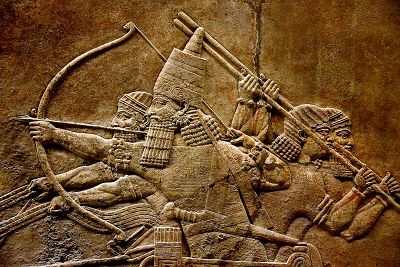
The Mesopotamians believed their kings and queens were descended from the city gods, but, unlike the ancient Egyptians, they never believed their kings were real gods.[34]
Power
When Assyria grew into an empire, it was divided into smaller parts, called provinces. Each of these were named after their main cities, like Nineveh, Samaria, Damascus, and Arpad. They all had their own governor who had to make sure everyone paid their taxes. Governors also had to call up soldiers to war and supply workers when a temple was built. He was also responsible for enforcing the laws. In this way, it was easier to keep control of a large empire. Although Babylon was quite a small state in Sumer, it grew tremendously throughout the time of Hammurabi's rule. He was known as "the lawmaker" and created the Code of Hammurabi, and soon Babylon became one of the main cities in Mesopotamia. It was later called Babylonia, which meant "the gateway of the gods." It also became one of history's greatest centers of learning.
Warfare
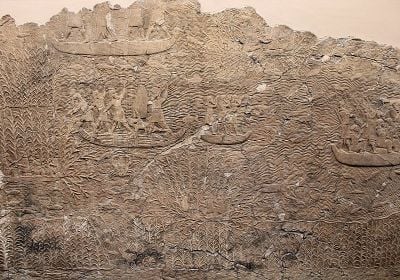
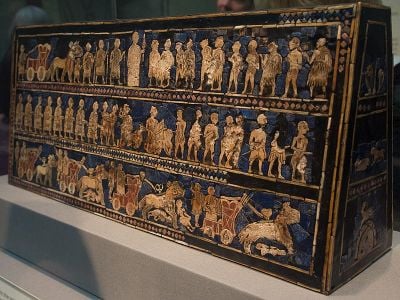
With the end of the Uruk phase, walled cities grew and many isolated Ubaid villages were abandoned, indicating a rise in communal violence. As city-states began to grow, their spheres of influence overlapped, creating arguments between other city-states, especially over land and canals. These arguments were recorded in tablets several hundreds of years before any major war—the first recording of a war occurred around 3200 B.C.E. but was not common until about 2500 B.C.E.
An Early Dynastic II king (Ensi) of Uruk in Sumer, Gilgamesh (c. 2600 B.C.E.), was commended for military exploits against Humbaba guardian of the Cedar Mountain, and was later celebrated in many later poems and songs in which he was claimed to be two-thirds god and only one-third human. The later Stele of the Vultures at the end of the Early Dynastic III period (2600–2350 B.C.E.), commemorating the victory of Eannatum of Lagash over the neighboring rival city of Umma, is the oldest monument in the world that celebrates a massacre.[35] From this point forwards, warfare was incorporated into the Mesopotamian political system. At times a neutral city might act as an arbitrator for the two rival cities. This helped to form unions between cities, leading to regional states.[34] When empires were created, they went to war more with foreign countries. King Sargon, for example, conquered all the cities of Sumer, some cities in Mari, and then went to war with cities in modern-day Syria. Many Assyrian and Babylonian palace walls were decorated with the pictures of the successful fights and the enemy either desperately escaping or hiding amongst reeds.
The Neo-Babylonian kings used deportation as a means of control, like their predecessors, the Assyrians. For the Neo-Babylonian kings, war was a means to obtain tribute, plunder, sought after materials such as various metals and quality wood) and prisoners of war which could be put to work as slaves in the temples which they built. The Assyrians had displaced populations throughout their vast empire, however, this particular practice under the Babylonian kings would appear to have been more limited, only being used to establish new populations in Babylonia itself. Though royal inscriptions from the Neo-Babylonian period don't speak of acts of destruction and deportation in the same boastful way royal inscriptions from the Neo-Assyrian period do, this however, does not prove that the practice ceased or that the Babylonians were less brutal than the Assyrians, since there is evidence that the city Ascalon was destroyed by Nebuchadnezzar II in 604 B.C.E.[36]
Laws
City-states of Mesopotamia created the first law codes, drawn from legal precedence and decisions made by kings. The codes of Urukagina and Lipit-Ishtar (the Code of Lipit-Ishtar) have been found. The most renowned of these is the Code of Hammurabi (created c. 1780 B.C.E.), which is one of the earliest sets of laws found and one of the best preserved examples of this type of document from ancient Mesopotamia. Hammurabi codified over 200 laws for Mesopotamia. Examination of the laws show a progressive weakening of the rights of women, and increasing severity in the treatment of slaves.[37]
Art
The art of Mesopotamia rivaled that of Ancient Egypt as the most grand, sophisticated and elaborate in western Eurasia from the fourth millennium B.C.E. until the Persian Achaemenid Empire conquered the region in the sixth century B.C.E. The main emphasis was on various, very durable, forms of sculpture in stone and clay; little painting has survived, but what has suggests that painting was mainly used for geometrical and plant-based decorative schemes, though most sculpture was also painted.
The Protoliterate period, dominated by Uruk, saw the production of sophisticated works like the Warka Vase and cylinder seals. The Guennol Lioness is an outstanding small limestone figure from Elam of about 3000–2800 B.C.E., part man and part lion. A little later there are a number of figures of large-eyed priests and worshipers, mostly in alabaster and up to a foot high, who attended temple cult images of the deity, but very few of these have survived. Sculptures from the Sumerian and Akkadian period generally had large, staring eyes, and long beards on the men. Many masterpieces have also been found at the Royal Cemetery at Ur (c. 2650 B.C.E.), including the two figures of a Ram in a Thicket, the Copper Bull and a bull's head on one of the Lyres of Ur[38]
From the many subsequent periods before the ascendancy of the Neo-Assyrian Empire Mesopotamian art survives in a number of forms: cylinder seals, relatively small figures in the round, and reliefs of various sizes, including cheap plaques of molded pottery for the home, some religious and some apparently not. The Burney Relief is an unusual elaborate and relatively large (20 x 15 inches) terracotta plaque of a naked winged goddess with the feet of a bird of prey, and attendant owls and lions. It comes from the eighteenth or nineteenth century B.C.E., and may also be molded. Stone stelae, votive offerings, or ones probably commemorating victories and showing feasts, are also found from temples, which unlike more official ones lack inscriptions that would explain them; the fragmentary Stele of the Vultures is an early example of the inscribed type, and the Assyrian Black Obelisk of Shalmaneser III a large and solid late one.[38]
The conquest of the whole of Mesopotamia and much surrounding territory by the Assyrians created a larger and wealthier state than the region had known before, and very grandiose art in palaces and public places, no doubt partly intended to match the splendor of the art of the neighboring Egyptian empire. The Assyrians developed a style of extremely large schemes of very finely detailed narrative low reliefs in stone for palaces, with scenes of war or hunting. They produced very little sculpture in the round, except for colossal guardian figures, often the human-headed lamassu, which are sculpted in high relief on two sides of a rectangular block, with the heads effectively in the round (and also five legs, so that both views seem complete). Even before dominating the region they had continued the cylinder seal tradition with designs which are often exceptionally energetic and refined.[38]
Bronze head of an Akkadian ruler, discovered in Nineveh in 1931, presumably depicting either Sargon of Akkad or Sargon's grandson Naram-Sin.
Striding lions from the Processional Street of Babylon
Detail of Nebuchadnezzar II's Building Inscription plaque of the Ishtar Gate, from Babylon
Artist's impression of a hall in an Assyrian palace from The Monuments of Nineveh by Austen Henry Layard, 1853
Architecture
The study of ancient Mesopotamian architecture is based on available archaeological evidence, pictorial representation of buildings, and texts on building practices. Scholarly literature usually concentrates on temples, palaces, city walls and gates, and other monumental buildings, but occasionally one finds works on residential architecture as well.[36] Archaeological surface surveys also allowed for the study of urban form in early Mesopotamian cities.
Brick is the dominant material, as the material was freely available locally, whereas building stone had to be brought a considerable distance to most cities. The ziggurat is the most distinctive form, and cities often had large gateways, of which the Ishtar Gate from Neo-Babylonian Babylon, decorated with beasts in polychrome brick, is the most famous, now largely in the Pergamon Museum in Berlin.
The most notable architectural remains from early Mesopotamia are the temple complexes at Uruk from the fourth millennium B.C.E., temples and palaces from the Early Dynastic period sites in the Diyala River valley such as Khafajah and Tell Asmar, the Third Dynasty of Ur remains at Nippur (Sanctuary of Enlil) and Ur (Sanctuary of Nanna), Middle Bronze Age remains at Syrian-Turkish sites of Ebla, Mari, Alalakh, Aleppo, and Kultepe, Late Bronze Age palaces at Hattusa, Ugarit, Ashur, and Nuzi, Iron Age palaces and temples at Assyrian (Kalhu/Nimrud, Khorsabad, Nineveh), Babylonian (Babylon), Urartian (Tushpa/Van, Kalesi, Cavustepe, Ayanis, Armavir, Erebuni, Bastam), and Neo-Hittite sites (Karkamis, Tell Halaf, Karatepe). Houses are mostly known from Old Babylonian remains at Nippur and Ur. Among the textual sources on building construction and associated rituals are Gudea's cylinders from the late third millennium are notable, as well as the Assyrian and Babylonian royal inscriptions from the Iron Age.
The Ishtar gate was constructed in about 575 B.C.E. by order of King Nebuchadnezzar II. Pergamon Museum, Berlin
The walls of Babylon, in Babylon
The alleged Abraham house in Ur
Notes
- ↑ Turkish: Mezopotamya; Ancient Greek: Μεσοποταμία Mesopotamíā; Arabic: بِلَاد ٱلرَّافِدَيْن Bilād ar-Rāfidayn or بَيْنُ ٱلْنَهْرَيْن Bayn ul-Nahrayn; Classical Syriac: ܒܝܬ ܢܗܪ̈ܝܢ; Bēṯ Nahrēn
- ↑ Mesopotamia 1911 Encyclopædia Britannica. Retrieved March 19, 2024.
- ↑ Benjamin R. Foster and Karen Polinger Foster, Civilizations of Ancient Iraq (Princeton University Press, 2009, ISBN 978-0691137223).
- ↑ Roger Matthews, Archaeology of Mesopotamia: Theories and Approaches (Routledge, 2003, ISBN 978-0415253178).
- ↑ Guy Le Strange, The Lands Of The Eastern Caliphate: Mesopotamia, Persia And Central Asia; From The Moslem Conquest To The Time Of Timur (Cosimo Classics, 2011 (original 1905), ISBN 1616405120).
- ↑ 6.0 6.1 Corine Wegener, In the Cradle of Civilization, a New Generation Preserves Heritage Smithsonian Global, August 22, 2017. Retrieved March 21, 2024.
- ↑ Susan Pollock, Ancient Mesopotamia: The Eden that Never Was (Cambridge University Press, 1999, ISBN 978-0521573344).
- ↑ Geoffrey Broadbent and C.A. Brebbia (eds.), Eco-architecture II: Harmonisation Between Architecture and Nature (WIT Press, 2008, ISBN 978-1845641191).
- ↑ 9.0 9.1 Norman Yoffee (ed.), Early Cities in Comparative Perspective, 4000 B.C.E.–1200 C.E. (Cambridge University Press, 2017, ISBN 978-1108407694).
- ↑ Dominique Collon, Early writing BBC History. Retrieved March 23, 2024.
- ↑ Rongxing Guo, An Economic Inquiry into the Nonlinear Behaviors of Nations: Dynamic Developments and the Origins of Civilizations (Palgrave Macmillan, 2017, ISBN 978-3319487717).
- ↑ Seth L. Sanders (ed.), Margins of Writing, Origins of Cultures (Oriental Institute of the University of Chicago, 2006, ISBN 978-1885923394).
- ↑ Elizabeth Meier Tetlow, Women, Crime and Punishment in Ancient Law and Society: Volume 1: The Ancient Near East (Continuum, 2004, ISBN 978-0826416285).
- ↑ Howard Eves, An Introduction to the History of Mathematics (Cengage Learning, 1990, ISBN 0030295580).
- ↑ Dirk J. Struik, A Concise History of (Dover Publications, 1987, ISBN 978-0486602554).
- ↑ Duncan J. Melville, YBC 7289 Mesopotamian Mathematics. Retrieved March 23, 2024.
- ↑ Carl B. Boyer, A History of Mathematics (Wiley, 1991, ISBN 978-0471543978).
- ↑ David E. Joyce, Plimpton 322 Retrieved March 23, 024.
- ↑ David Brown, Mesopotamian Planetary Astronomy-Astrology, Brill, 2000, ISBN 978-9056930363).
- ↑ Stephanie Dalley (ed.), The Legacy of Mesopotamia (Oxford University Press, 1998, ISBN 978-0198149460).
- ↑ William P.D. Wightman, The Growth Of Scientific Ideas (Kessinger Publishing, 2009 (original 1951), ISBN 978-1104847555).
- ↑ 22.0 22.1 22.2 Manfred Horstmanshoff and Marten Stol (eds.), Magic And Rationality In Ancient Near Eastern And Graeco-Roman Medicine (Brill Academic Pub., 2004, ISBN 978-9004136663).
- ↑ Marten Stol, Epilepsy in Babylonia (Brill, 1993, ISBN 978-9072371638).
- ↑ Wilfred G. Lambert, Ancient Mesopotamian Religion and Mythology: Selected Essays (Mohr Siebrek, 2016, ISBN 978-3161536748).
- ↑ Norriss S. Hetherington (ed.), Encyclopedia of Cosmology: Historical, Philosophical, and Scientific Foundations of Modern Cosmology (Routledge, 2015, ISBN 978-1138778153).
- ↑ Stephen Bertman, Handbook to Life in Ancient Mesopotamia (Oxford University Press, 2005, ISBN 978-0195183641).
- ↑ 27.0 27.1 Giorgio Buccellati, "Wisdom and Not: The Case of Mesopotamia" Journal of the American Oriental Society 101(1) (1981):35–47. Retrieved March 24, 2024.
- ↑ Jeremy Black and Anthony Green, Gods, Demons and Symbols of Ancient Mesopotamia: An Illustrated Dictionary (The British Museum Press, 1992, ISBN 978-0714117058).
- ↑ Karen Rhea Nemet-Nejat, Daily Life in Ancient Mesopotamia (Hendrickson Pub., 2002, ISBN 978-1565637122).
- ↑ Rivkah Harris, Gender and Aging in Mesopotamia (University of Oklahoma Press, 2000, ISBN 978-0806131672).
- ↑ Samuel Noah Kramer, The Sumerians: Their History, Culture, and Character (University of Chicago Press, 1971, ISBN 978-0226452388).
- ↑ Richard Bulliet, Pamela Crossley, Daniel Headrick, Steven Hirsch, Lyman Johnson, and David Northup, The Earth and Its Peoples: A Global History (Wadsworth Publishing, 2010, ISBN 978-0538744386).
- ↑ Mortimer Wheeler, The Indus Civilization (Cambridge University Press, 1968, ISBN 978-0521095389).
- ↑ 34.0 34.1 Robert Dalling, The Story of Us Humans, from Atoms to Today's Civilization (iUniverse, 2006, ISBN 978-0595391172).
- ↑ Irene J. Winter, On Art in the Ancient Near East, Volume 2: From the Third Millennium B.C.E. (Brill Academic Pub., 2009, ISBN 978-9004174993).
- ↑ 36.0 36.1 Daniel C. Snell, (ed.), A Companion to the Ancient Near East (Wiley-Blackwell, 2007, ISBN 978-1405160018).
- ↑ F. Charles Fensham, "Widow, Orphan, and the Poor in Ancient near Eastern Legal and Wisdom Literature" Journal of Near Eastern Studies 21(2) (April 1962): 129–139. Retrieved March 25, 2024.
- ↑ 38.0 38.1 38.2 Henri Frankfort, The Art and Architecture of the Ancient Orient (Puffin, 1977, ISBN 978-0140561074).
ReferencesISBN links support NWE through referral fees
- Bertman, Stephen. Handbook to Life in Ancient Mesopotamia. Oxford University Press, 2005. ISBN 978-0195183641
- Black, Jeremy, and Anthony Green. Gods, Demons and Symbols of Ancient Mesopotamia: An Illustrated Dictionary. The British Museum Press, 1992. ISBN 978-0714117058
- Boyer, Carl B. A History of Mathematics. Wiley, 1991. ISBN 978-0471543978
- Broadbent, Geoffrey, and C.A. Brebbia (eds.). Eco-architecture II: Harmonisation Between Architecture and Nature. WIT Press, 2008. ISBN 978-1845641191
- Brown, David. Mesopotamian Planetary Astronomy-Astrology. Brill, 2000. ISBN 978-9056930363
- Bulliet, Richard, Pamela Crossley, Daniel Headrick, Steven Hirsch, Lyman Johnson, and David Northup. The Earth and Its Peoples: A Global History. Wadsworth Publishing, 2010. ISBN 978-0538744386.
- Dalley, Stephanie (ed.). The Legacy of Mesopotamia. Oxford University Press, 1998. ISBN 978-0198149460
- Dalling, Robert. The Story of Us Humans, from Atoms to Today's Civilization. iUniverse, 2006. ISBN 978-0595391172
- Eves, Howard. An Introduction to the History of Mathematics. Cengage Learning, 1990. ISBN 0030295580
- Foster, Benjamin R., and Karen Polinger Foster. Civilizations of Ancient Iraq. Princeton University Press, 2009. ISBN 978-0691137223
- Frankfort, Henri. The Art and Architecture of the Ancient Orient. Puffin, 1977. ISBN 978-0140561074
- Guo, Rongxing. An Economic Inquiry into the Nonlinear Behaviors of Nations: Dynamic Developments and the Origins of Civilizations. Palgrave Macmillan, 2017. ISBN 978-3319487717
- Harris, Rivkah. Gender and Aging in Mesopotamia. University of Oklahoma Press, 2000. ISBN 978-0806131672
- Hetherington, Norriss S. (ed.). Encyclopedia of Cosmology: Historical, Philosophical, and Scientific Foundations of Modern Cosmology. Routledge, 2015. ISBN 978-1138778153
- Horstmanshoff, Manfred, and Marten Stol (eds.). Magic And Rationality In Ancient Near Eastern And Graeco-Roman Medicine. Brill Academic Pub., 2004. ISBN 978-9004136663
- Kramer, Samuel Noah. The Sumerians: Their History, Culture, and Character. University of Chicago Press, 1971. ISBN 978-0226452388
- Le Strange, Guy. The Lands Of The Eastern Caliphate: Mesopotamia, Persia And Central Asia; From The Moslem Conquest To The Time Of Timur. Cosimo Classics, 2011 (original 1905). ISBN 1616405120
- Matthews, Roger. Archaeology of Mesopotamia: Theories and Approaches. Routledge, 2003. ISBN 978-0415253178
- Nemet-Nejat, Karen Rhea. Daily Life in Ancient Mesopotamia. Hendrickson Pub., 2002. ISBN 978-1565637122
- Pollock, Susan. Ancient Mesopotamia: The Eden that Never Was. Cambridge University Press, 1999. ISBN 978-0521573344
- Sanders, Seth L. (ed.). Margins of Writing, Origins of Cultures. Oriental Institute of the University of Chicago, 2006. ISBN 978-1885923394
- Snell, Daniel C. (ed.). A Companion to the Ancient Near East. Wiley-Blackwell, 2007. ISBN 978-1405160018
- Stol, Marten. Epilepsy in Babylonia. Brill, 1993. ISBN 978-9072371638
- Struik, Dirk J. A Concise History of Mathematics. Dover Publications, 1987. ISBN 978-0486602554
- Tetlow, Elizabeth Meier. Women, Crime and Punishment in Ancient Law and Society: Volume 1: The Ancient Near East. Continuum, 2004. ISBN 978-0826416285
- Wheeler, Mortimer. The Indus Civilization. Cambridge University Press, 1968. ISBN 978-0521095389
- Wightman, William P.D. The Growth Of Scientific Ideas. Kessinger Publishing, 2009 (original 1951). ISBN 978-1104847555
- Yoffee, Norman (ed.). Early Cities in Comparative Perspective, 4000 B.C.E.–1200 C.E.. Cambridge University Press, 2017. ISBN 978-1108407694
External links
All links retrieved March 18, 2024.
- Mesopotamia World History Encyclopedia
- Mesopotamia The British Museum
- Mesopotamia National Geographic
- Mesopotamia: Civilization Begins The J. Paul Getty Museum
- Ancient Mesopotamia - an overview University of Cambridge
Credits
New World Encyclopedia writers and editors rewrote and completed the Wikipedia article in accordance with New World Encyclopedia standards. This article abides by terms of the Creative Commons CC-by-sa 3.0 License (CC-by-sa), which may be used and disseminated with proper attribution. Credit is due under the terms of this license that can reference both the New World Encyclopedia contributors and the selfless volunteer contributors of the Wikimedia Foundation. To cite this article click here for a list of acceptable citing formats.The history of earlier contributions by wikipedians is accessible to researchers here:
The history of this article since it was imported to New World Encyclopedia:
Note: Some restrictions may apply to use of individual images which are separately licensed.
